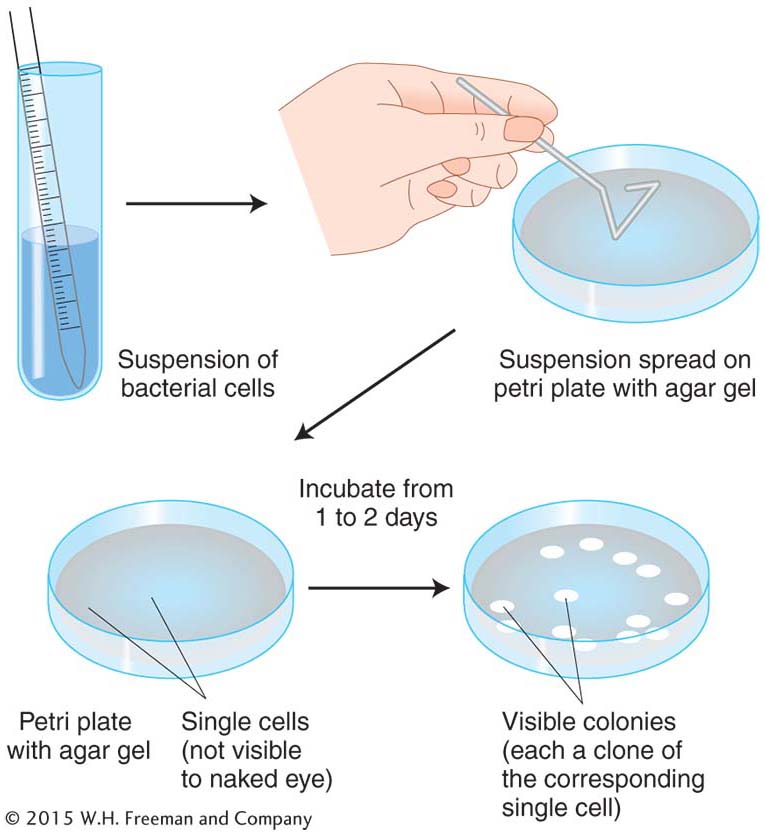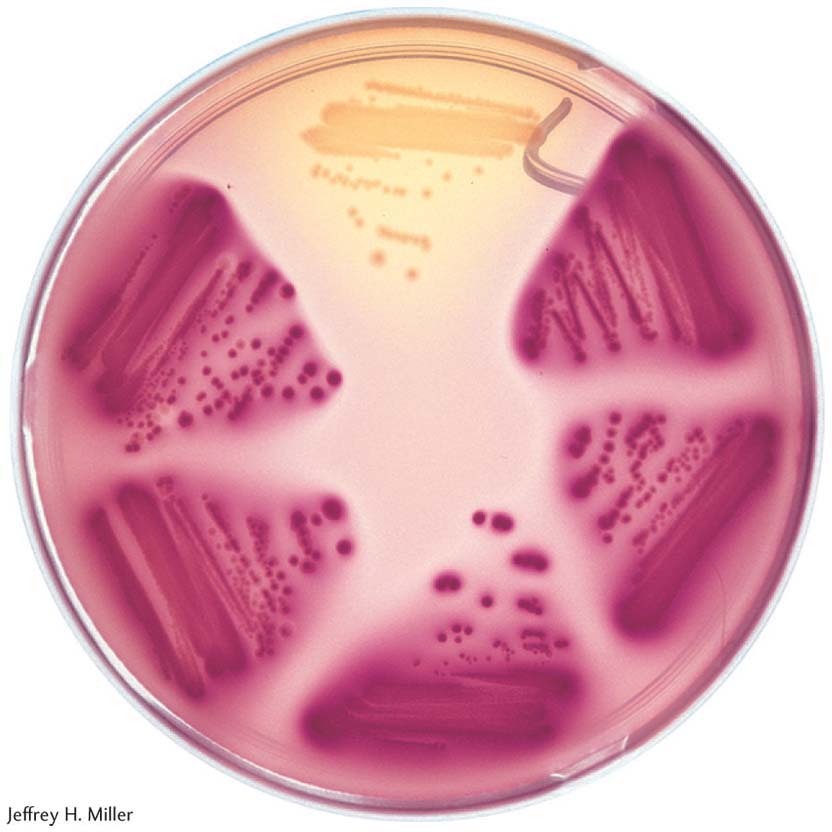5.1 Working with Microorganisms

Figure 5-3: Bacterial colonies, each derived from a single cell
Figure 5-3: Bacterial phenotypes can be assessed in their colonies. A stock of bacterial cells can be grown in a liquid medium containing nutrients, and then a small number of bacteria from the liquid suspension can be spread on solid agar medium. Each cell will give rise to a colony. All cells in a colony have the same genotype and phenotype.
Bacteria are fast-dividing and take up little space; so they are very convenient to use as genetic model organisms. They can be cultured in a liquid medium or on a solid surface such as an agar gel, as long as basic nutrients are supplied. Each bacterial cell divides asexually from 1 → 2 → 4 → 8 → 16 cells, and so on, until the nutrients are exhausted or until toxic waste products accumulate to levels that halt the population growth. A small amount of a liquid culture can be pipetted onto a petri plate containing solid agar medium and spread evenly on the surface with a sterile spreader, in a process called plating (Figure 5-3). The cells divide, but, because they cannot travel far on the surface of the gel, all the cells remain together in a clump. When this mass reaches more than 107 cells, it becomes visible to the naked eye as a colony. Each distinct colony on the plate has been derived from a single original cell. Members of a colony that have a single genetic ancestor are known as cell clones.
Bacterial mutants are quite easy to obtain. Nutritional mutants are a good example. Wild-type bacteria are prototrophic, which means that they can grow and divide on minimal medium—a substrate containing only inorganic salts, a carbon source for energy, and water. From a prototrophic culture, auxotrophic mutants can be obtained: these mutants are cells that will not grow unless the medium contains one or more specific cellular building blocks such as adenine, threonine, or biotin. Another type of useful mutant differs from wild type in the ability to use a specific energy source; for example, the wild type (lac+) can use lactose and grow, whereas a mutant (lac−) cannot. Figure 5-4 shows another way of distinguishing lac+ and lac− colonies by using a dye. In another mutant category, whereas wild types are susceptible to an inhibitor, such as the antibiotic streptomycin, resistant mutants can divide and form colonies in the presence of the inhibitor. All these types of mutants allow the geneticist to distinguish different individual strains, thereby providing genetic markers (marker alleles) to keep track of genomes and cells in experiments. Table 5-1 summarizes some mutant bacterial phenotypes and their genetic symbols.
|
|
Character or phenotype associated with symbol |
|
|
Requires biotin added as a supplement to minimal medium |
|
|
Requires arginine added as a supplement to minimal medium |
|
|
Requires methionine added as a supplement to minimal medium |
|
|
Cannot utilize lactose as a carbon source |
|
|
Cannot utilize galactose as a carbon source |
|
|
Resistant to the antibiotic streptomycin |
|
|
Sensitive to the antibiotic streptomycin |
Note: Minimal medium is the basic synthetic medium for bacterial growth without nutrient supplements. |
Table 5-1: Some Genotypic Symbols Used in Bacterial Genetics
The following sections document the discovery of the various processes by which bacterial genomes recombine. The historical methods are interesting in themselves but also serve to introduce the diverse processes of recombination, as well as analytical techniques that are still applicable today.

Figure 5-4: Distinguishing lac+ and lac− by using a red dye
Figure 5-4: Wild-type bacteria able to use lactose as an energy source (lac+) stain red in the presence of this indicator dye. The unstained cells are mutants unable to use lactose (lac−).
[Jeffrey H. Miller.]

